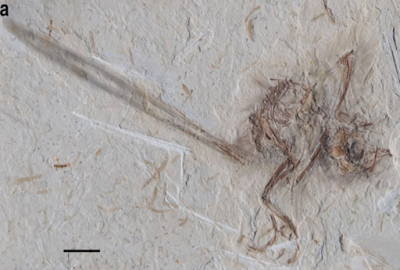
The 115-million-year-old remains of a tiny toothed bird with a two-pronged tail resembling a pair of darts have filled knowledge gaps about feather evolution, scientists reported Tuesday.
The remarkably-preserved 3-D specimen from northeast Brazil is the oldest bird fossil yet from Gondwana, the supercontinent that broke up into today’s southern landmasses.
Until now, birds with this unusual and now extinct tail design were known to have lived only in China, which was not part of Gondwana, during this period of Earth’s history.
“The bird looks like a small hummingbird,” study co-author Ismar Carvalho of the Federal University of Rio de Janeiro told AFP.
“It has big eyes, plumes (feathers) surrounding the body and two long feathers in the tail. There are also teeth in his beak.”
The critter measured about six centimetres (2.4 iches) from the tip of its nose to the beginning of its double-shafted, ribbon-like tail.
Not yet given a name, the new bird belonged to a group known as Enantiornithes whose members had teeth and clawed wings, and are not thought to have left any living descendants.
The fossil is exceptional in that the impression of the bird, left in rock, has not been totally flattened out.
Instead, the imprint retains some volume, which in turn greatly helps understanding of the bird’s shape and possible motion.
The team also found rows of spots distributed symmetrically along the tail feathers, which they took to be the remains of a colour pattern.
Given that the plumes did not appear to have been useful for body balance or flight, they were probably used for sexual display, species recognition or visual communication, the researchers concluded.
The earliest known relative of birds is generally agreed to be Archaeopteryx, considered a transitional species from non-avian dinosaurs with feathers which lived about 150 million years ago.
The study appears in the journal Nature Communications.
Reference:
Ismar de Souza Carvalho, Fernando E. Novas, Federico L. Agnolín, Marcelo P. Isasi, Francisco I. Freitas & José A. Andrade. A Mesozoic bird from Gondwana preserving feathers. DOI:10.1038/ncomms8141
Note : The above story is based on materials provided by AFP.










